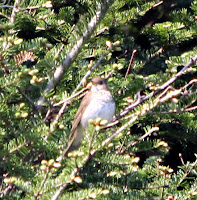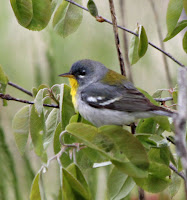The full report is available at www.stateofthebirds.org.
U.S. Department of the Interior
AMERICA’S GREAT OUTDOORS: Secretary Salazar Releases 2011 State of the Birds Report
Report Shows Public Lands and Waters Crucial to Birds; One Out of Four Birds Species on Public Land in Peril
05/03/2011
Contact: Hugh Vickery, DOI (202) 208-6414
Alicia F. King, FWS (571) 214-3117
WASHINGTON — Secretary of the Interior Ken Salazar and Agriculture Under Secretary for Natural Resources and Environment Harris Sherman today released the 2011 State of the Birds Report, the nation’s first assessment of birds on lands and waters owned by the American people. The findings indicate tremendous potential for bird conservation: these publicly owned habitats support at least half of the entire U.S. distributions of more than 300 bird species.
The report concludes that America’s public lands and waters, ranging from national wildlife refuges to national parks to national forests, offer significant opportunities to halt or reverse the decline of many species. More than 1,000 bird species inhabit the U.S., 251 of which are federally threatened, endangered, or of conservation concern. The report provides a scientific tool to help public agencies identify the most significant conservation opportunities in each habitat.
“The State of the Birds report is a measurable indicator of how well we are fulfilling our shared role as stewards of our nation’s public lands and waters,” Salazar said. “Although we have made enormous progress in conserving habitat on public lands, we clearly have much more work to do. The good news is that because birds so extensively use public lands and waters as habitat, effective management and conservation efforts can make a significant difference in whether these species recover or slide towards extinction.”
“The 2011 State of the Birds report reflects significant achievement by public agencies and all of our long-standing partners in improving bird habitats,” said Agriculture Under Secretary for Natural Resources and Environment Harris Sherman. “The USDA programs are innovative and creative. Over the last two years, the Natural Resources Conservation Service has played a critical role in working cooperatively with landowners to conserve migratory birds in the Gulf of Mexico, sage grouse in the great plains, and others. The Forest Service has developed a draft Forest Planning rule that will ensure our National Forests support birds and other wildlife for decades to come.”
The report assessed the distribution of birds on nearly 850 million acres of public land and 3.5 million square miles of ocean. It relied on high-performance computing techniques to generate detailed bird distribution maps based on citizen-science data reported to eBird and information from the U.S. Geological Survey’s Protected Areas Database of the United States.
The report highlighted the wide variety of bird habitats on public lands. These include:
Aridlands: More than half of U.S. aridlands are publicly owned. Thirty-nine percent of aridland bird species are of conservation concern and more than 75 percent of species are declining.
Oceans and Coasts: All U.S. marine waters are publicly owned and are home to 86 ocean bird species and 173 coastal species. At least 39 percent of U.S. bird species restricted to ocean habitats are declining and almost half are of conservation concern, indicating severe stress in these ecosystems.
Forests: Public lands include some of the largest unfragmented blocks of forest, which are crucial for the long-term health of many bird species, including the endangered Kirtland’s warbler, which has 97 percent of its U.S. distribution on public lands.
Arctic and Alpine: Ninety percent of boreal forest, alpine, and arctic breeding bird species in Alaska rely on public lands for habitat, including 34 breeding shorebird species of high conservation concern. There are more public lands in Alaska than in the rest of the U.S. combined, offering huge potential to manage lands for conservation.
Islands: More birds are in danger of extinction in Hawaii than anywhere else in the U.S. Public lands in Hawaii support 73 percent of the distribution of declining forest birds. Among declining Hawaiian forest birds on Kauai, about 78 percent rely on state land. Four endangered species in the Northwest Hawaiian Islands are entirely dependent on federal lands.
Wetlands: Wetlands protection has provided the “gold standard” for bird conservation. On the whole, 39 species of hunted waterfowl have increased by more than 100 percent during the past 40 years as nearly 30 million acres of wetlands have been acquired and management practices have restored bird populations.
Grasslands: Grassland birds are among our nation’s fastest declining species, yet only a small amount – 13 percent — of grassland is publicly owned and managed primarily for conservation. Forty-eight percent of grassland-breeding bird species are of conservation concern, including four with endangered populations.
The 2011 State of the Birds report is a collaborative effort as part of the U.S. North American Bird Conservation Initiative, involving federal and state wildlife agencies, and scientific and conservation organizations. These include the American Bird Conservancy, the Association of Fish and Wildlife Agencies, the Bureau of Land Management, the Cornell Lab of Ornithology, the Department of Defense, the National Audubon Society, The Nature Conservancy, the National Park Service, the U.S.D.A. Forest Service, the U.S. Fish and Wildlife Service, and the U.S. Geological Survey.
The full report is available at www.stateofthebirds.org.




















